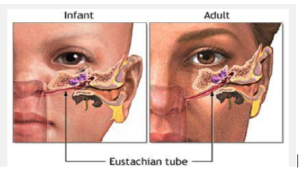

Don’t allow anyone to smoke in the home or around your child.

Your child may sleep better at night if they are propped up on two or more pillows (only do this if your child is old enough to use pillows).If your child has hearing troubles that don't improve in the weeks following a middle ear infection, or continues to be irritable, go back to the GP as your child may have glue ear.Children with an outer ear infection should avoid swimming for one week to allow the infection to heal.If your child’s doctor prescribes ear drops, have your child lie down with the affected ear facing the ceiling. Put the drops in and keep your child in the same position for a few minutes, to allow the drops to be absorbed (or place a cotton wool ball in the ear to keep the drops in the.If your child is in pain, you can give them pain relief, such as paracetamol or ibuprofen.These tubes help fluid drain from the middle ear. This is a quick operation during which small tubes (called grommets) are put into your child's ear. If the glue ear still persists and is affecting your child's hearing over many months, your doctor or ENT specialist may suggest surgery.Sometimes antibiotics are prescribed to kill any germs left in the middle ear, and this may help the fluid to clear.It usually goes away by itself over time. If your child is not bothered by the glue ear, no treatment is needed.Outer ear infections always need treatment with antibiotic drops.In very young or very unwell children, the GP may prescribe a short course of antibiotics if there's risk of bacterial infection. Antibiotics are not often used to treat middle ear infections, as they are often caused by a virus.Your GP may also refer them to see a paediatrician or an ear, nose and throat (ENT) specialist. If your child has frequent ear infections or their hearing appears to be affected by glue ear, they should have their hearing tested by a hearing specialist (an audiologist). You should visit your GP or local emergency department if there is redness, swelling or pain in this area.

If you think your child may have an ear infection, take them to see the GP.Ī middle ear infection may spread to the firm, bony area behind the ear. In smaller children, hearing difficulties may delay or stall their language development. Parents or teachers may notice this, especially in noisy places such as classrooms.


 0 kommentar(er)
0 kommentar(er)
